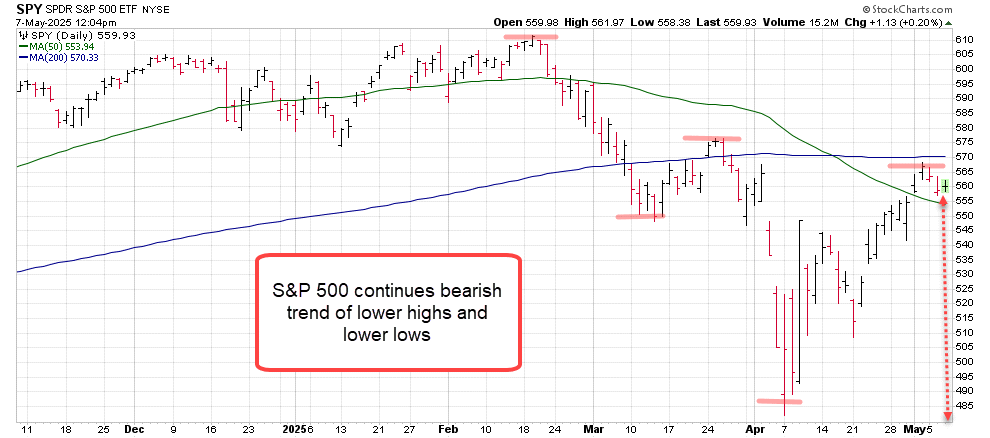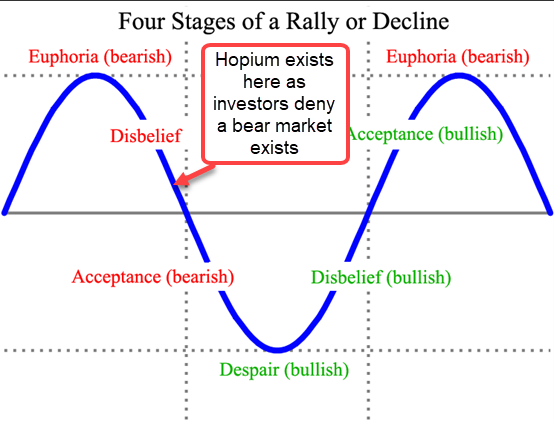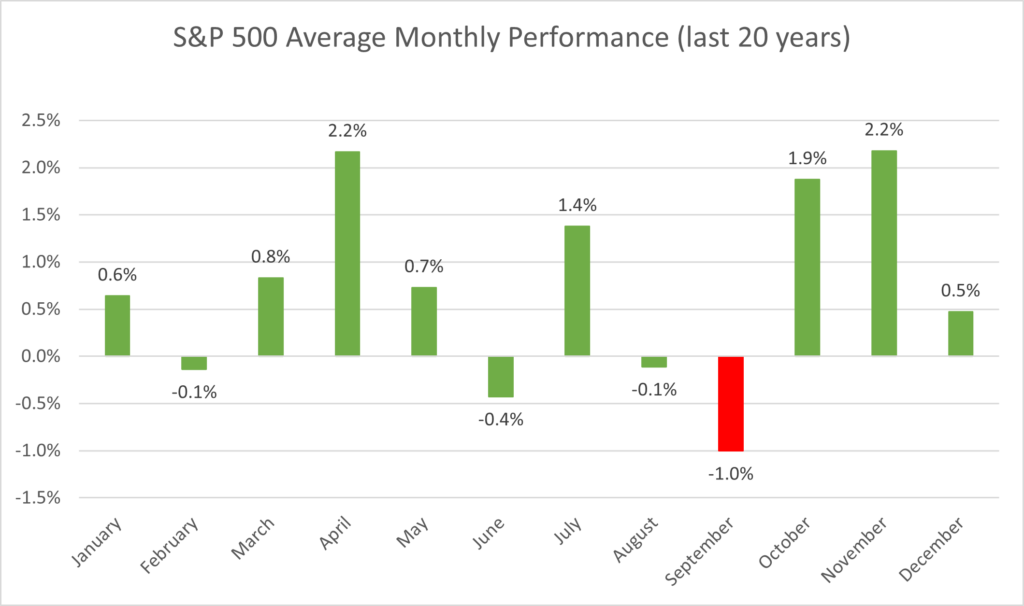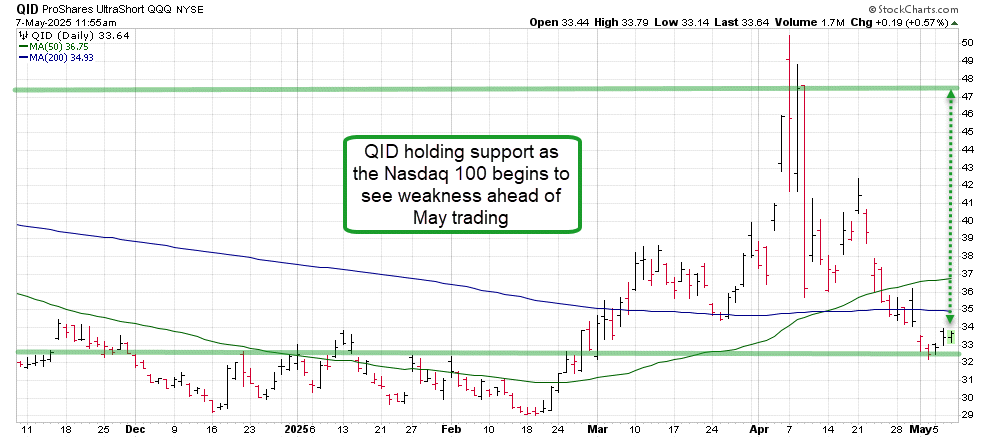There’s a reason the old saying “Sell in May and go away” has lasted so long – it’s because seasonality often matters.
For the Nasdaq 100 and the S&P 500, the stretch between May and October has historically been choppier, more volatile, and often less rewarding than in the year’s first few months.
And while it’s true that plenty of summers have produced gains, 2025 isn’t shaping up like one of those times.
In fact, the setup we’re seeing this year might be the most compelling argument for “Sell in May” that we’ve had in over a decade.
Why? Because not only are stocks coming off an emotionally charged rebound from their April lows, they’re still stuck in a long-term bear market trend. The trend is driven by deeply rooted macro uncertainty, political instability, and stubborn bullish sentiment.
Add that to the low volume/high volatility summer months and those issues are likely to compound, not fade.
Let’s break down why this summer could bring more pain than gains – and why raising cash or playing defense may be the smart move right now.
A Bear Market That Won’t Die
Let’s start with the big picture: despite the occasional rally, the Nasdaq 100 (QQQ) and S&P 500 (SPY) remain trapped in a long-term bear market structure.
The trendlines don’t lie—both indices continue to make lower highs and struggle at overhead resistance. Even when tech stocks get a short-term bid, that strength has been met with aggressive selling, not follow-through buying.
 That’s classic bear market behavior: violent rallies, sharp reversals, and ultimately, a grind lower.
That’s classic bear market behavior: violent rallies, sharp reversals, and ultimately, a grind lower.
We saw this in April when both indices sold off hard, and while they’ve regained some of those losses in recent sessions, the market’s underlying internals remain weak.
Breadth is weak, volume is suspect, and volatility is simmering just under the surface.
Now, we’re heading into the time of year when all those cracks in the foundation tend to widen.
Investor Sentiment Is Flashing Red
If there’s one thing that makes 2025 feel different from previous years, it’s the level of fear in the market right now. Investor sentiment—both institutional and retail—is at panic levels.
The recent AAII Sentiment Survey recently showed 61.9% of investors bearish, the highest percentage in its 38-year history.
In an expected twist, the CNN Fear & Greed Index has turned to “greed” already. This follows weeks of “fear” and “extreme fear” readings. This move tells us that the “hopium” trade is in full force.
Unfortunately, investor’s willingness to keep trying to catch the falling knife will work against us in the summer months.
 Fund managers are pulling back, retail traders are dumping positions, and even corporate insiders have gone quiet.
Fund managers are pulling back, retail traders are dumping positions, and even corporate insiders have gone quiet.
This kind of sentiment and action coincides with market bottoms – but not always.
Sometimes, it signals a deep loss of confidence in leadership, in the economic outlook, and in the direction of policy. That’s exactly what we’re seeing today.
 The sentiment environment right now isn’t just cautious – it’s adjusting to the reality that stocks are falling into a long-term bear market. That doesn’t bode well for the next few months, especially in a seasonally weak window where even modest bad news can send stocks reeling.
The sentiment environment right now isn’t just cautious – it’s adjusting to the reality that stocks are falling into a long-term bear market. That doesn’t bode well for the next few months, especially in a seasonally weak window where even modest bad news can send stocks reeling.
The Triggers Are Already in Play
Bearish sentiment alone wouldn’t be enough to make the “Sell in May” case. But when you add in the catalysts that are already in motion, the risk-reward calculus shifts fast.
Here’s what we’re facing as we head into the summer:
1. Tariffs and Trade Tensions
The U.S. has reintroduced tariffs on Chinese goods in 2025, triggering retaliatory threats from Beijing. That’s a major headwind for multinational tech and industrial companies, many of which rely on global supply chains and China’s manufacturing base. These headlines have already rattled markets, and there’s no sign of clarity coming soon.
This trade war 2.0 scenario is far more dangerous in a low-volume summer market. Even minor developments can spark outsized price swings. And if we get another escalation in rhetoric or policy, expect that volatility to surge.
2. Uncertainty at the Fed
After a historic round of rate hikes, the Federal Reserve has gone quiet—but investors aren’t buying the pause. In fact, there’s growing concern that the Fed may not be acting independently, especially with reports of political pressure around monetary policy decisions.
That’s unnerving for markets, which thrive on predictability from the central bank. In 2025, with inflation still above target and growth sputtering, the Fed is stuck between a rock and a hard place—and that indecision is feeding uncertainty.
3. Geopolitical Landmines
From the war in Ukraine to rising tensions in the Taiwan Strait and Middle East, the global backdrop remains volatile.
While markets have become somewhat desensitized to geopolitical risk, summer is a dangerous time for surprises. One wrong headline could easily trigger a flight to safety, especially in a market already stretched on valuation.
4. Tax and Fiscal Policy Gridlock
The 2025 tax debate is heating up. Key provisions from the 2017 tax cuts are set to expire soon, and no one knows what direction the new Congress will take. Will they extend pro-growth policies? Or will they stall out in partisan gridlock?
The lack of clarity here is already impacting business sentiment, which in turn weighs on capital spending. It’s another layer of uncertainty that investors will have to price in over the coming months.
The Seasonal Forces Aren’t Friendly
Even in normal years, August and September are the most volatile and worst-performing months for stocks. This isn’t opinion—it’s history. September has the lowest average returns of any month going back nearly a century. Volatility typically rises from July into late September, driven by thin trading volume, investor fatigue, and earnings season hangovers.
And that’s the other part of this equation: while July earnings often provide a short-term bounce for stocks, that strength tends to fade fast.
 We’ve seen it time and again – companies beat expectations in July, the market rallies, and by mid-August the gains are erased on renewed concerns about growth or policy.
We’ve seen it time and again – companies beat expectations in July, the market rallies, and by mid-August the gains are erased on renewed concerns about growth or policy.
There’s no reason to believe this year will be any different.
If anything, the earnings bar is higher now, and with consumer spending slowing and margins under pressure, the chance of widespread earnings upside surprises is lower than usual.
Bottom Line: Prepare, Don’t Panic
I’m not saying you should sell everything and go to cash. But if you’ve enjoyed the rebound off the April lows, this might be a great time to rebalance your portfolio, take profits where you can, and prepare for volatility.
The “Sell in May” strategy doesn’t mean sit out the entire summer. It means recognizing that this stretch of the year carries higher risk and less reward—especially in a market that’s already struggling to find direction.
We’re in a long-term bear trend. The sentiment is toxic. The macro triggers are real and unresolved. And the calendar tells us we’re headed into a historically tough part of the year.
Protect Your Portfolio from the Summer Swoon
First, control losses.
Every investor out there is well-served to review their portfolio holdings on a regular basis. Now is the time!
You’ll find that the nimble traders are setting stop-limit sell orders to ensure that losses don’t get out of control. This is an easy way to take the emotions out of investing that pays off over the long run.
One suggestion, if you sell a stock that you want in your portfolio for the long run consider setting a target price at which you’ll buy it back. This will help to make sure that you’re defensive to avoid losses pays off by buying the stock back at a lower price.
Second, Hedge your portfolio
Consider adding an inverse Exchange Traded Fund (ETF) or a defensive put to your portfolio.
Inverse ETFs are an investment that increases in value as the market goes down.
For example, the Ultrashort QQQ ETF (QID) goes up roughly 2% for every 1% decline in the Nasdaq 100.
Adding the QID to a portfolio will help to offset losses that you would see from holding large cap technology stocks in your portfolio.
As it stands right now, the QID shares are near the $32.50 level. This is the price that saw an explosion to the upside in April as the Nasdaq 100 started its next leg lower.
The ETF is an easy addition to a portfolio since you buy it just as you would with any stock.
Pro tip: Don’t get too greedy with a hedge like the QID. Set a target price for closing the positions. There’s nothing worse than holding a portfolio hedge too long to have it start losing money.
As of now, my charts suggest that a potential closeout for a QID position would be between $47.50 and $50. That’s 40-50 percent higher than where it sits as of this writing.
 — Chris Johnson
— Chris Johnson
$3 billion+ in operating income. Market cap under $8 billion. 15% revenue growth. 20% dividend growth. No other American stock but ONE can meet these criteria... here's why Donald Trump publicly backed it on Truth Social. See His Breakdown of the Seven Stocks You Should Own Here.
Source: Money Morning
